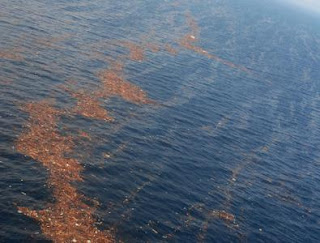Japan Tsunami Debris: Millions Of Tons Headed For West Coast, Almost a year after an earthquake sent 130-foot tsunami waves sweeping over the coast of Japan, the debris from ruined fishing boats and washed-out villages is creeping toward the U.S., with the first wave expected to hit northwestern Hawaii any day now.
Between 1 million and 2 million tons of debris generated by the March 11, 2011, tsunami is still crawling across the North Pacific and is likely to hit the coastline of Washington, Oregon and Alaska in 2013, scientists with the National Oceanic and Atmospheric Administration and the University of Hawaii said Tuesday.
Though up to 8 million tons of debris washed out to sea as large floating islands of lumber, rooftops and pieces of twisted metal and plastic, much of it sank near shore. Most of what remains has dispersed into isolated floating remnants of the tragedy that killed 15,844 people and left more than 3,400 others missing.
“Typically, people see one object at a time,” said Nikolai Maximenko, a senior researcher at the University of Hawaii’s International Pacific Research Center. He spoke with reporters in a conference call organized by the marine stewardship group Ocean Conservancy.
Researchers say there is little chance the debris is radioactive, because most of it was already out to sea or miles down the coast when the Fukushima nuclear power plant began having trouble. But pieces of it are large enough to present a hazard to navigation — one of the reasons NOAA wants to track the debris.
Lately, researchers have been focusing on the Midway atoll, where the debris was first expected to make landfall in December; due to a shift in currents, the debris veered slightly. “Now the situation has changed and the edge of the tsunami field may be much closer to Midway,” Maximenko said.
Using a series of maps and computer models, scientists show the debris continuing to drift eastward, reaching the northwestern Hawaiian Islands soon, with the leading edge of the main debris field hitting the Pacific Northwest and Alaska sometime next year.
Then, instead of continuing down to California, the debris is expected to circle back around through the Hawaiian Islands between 2014 and 2016 before joining the mother of all debris fields, the Great Pacific Garbage Patch, which extends across at least 270,000 square miles of the North Pacific.
(Actually, scientists say, there are five confirmed garbage patches, or "gyres," moving through the Pacific Ocean.)
The proliferation of marine garbage will make it increasingly difficult to distinguish tsunami debris from the dismal abundance of discarded plastic and other trash that populates the world’s oceans.
So far, there have been only two sightings of tsunami detritus: a pair of fishing vessels, both positively linked to the earthquake-ravaged regions of Japan, that were found in the middle of the Pacific.
Passers-by have recently reported seeing various buoys and other items on beaches from Seaside, Ore., to Washington’s Olympic Peninsula, but Ruth Yender of NOAA’s marine debris program said she doubts they came from Japan. “One of the challenges is that, unlike the vessels, most of the debris that will be associated with the tsunami we don’t expect to be identifiable, or easily recognizable,” she said.
"By April 14, just a little more than a month after the tsunami occurred, our satellites were no longer able to detect debris fields," she said.
That will be disappointing news for the folks in coastal Oregon, who already have been talking about attracting tourists for scavenger hunts and launching programs to reunite Japanese citizens with their belongings.
"It is an unfortunate series of events that have led to this debris,” Jon Rahl, director of tourism marketing for the Seaside Visitors Bureau, told the Seaside Signal newspaper in January. “But any time we can have a unique situation anywhere, let alone the coast, there is going to be a natural draw towards seeing the event.”
Source:http://www.latimes.com/news/nation/nationnow/la-na-nn-tsunami-debris-20120228,0,31163.story
skip to main |
skip to sidebar
Categories
- Amazing (75)
- Animals (37)
- Art (27)
- Articles (47)
- Celebrities (295)
- Cool (78)
- Interesting (108)
- News (616)
- Sports (19)
- Weird (19)
Blog Archive
- January (1)
- May (1)
- April (10)
- March (35)
- October (2)
- September (3)
- August (9)
- July (34)
- June (18)
- May (54)
- April (46)
- March (1)
- February (7)
- January (15)
- December (2)
- November (4)
- October (62)
- September (331)
- August (394)
- July (205)
- June (98)
- May (48)
- April (31)
- March (196)
- February (657)
- January (54)
